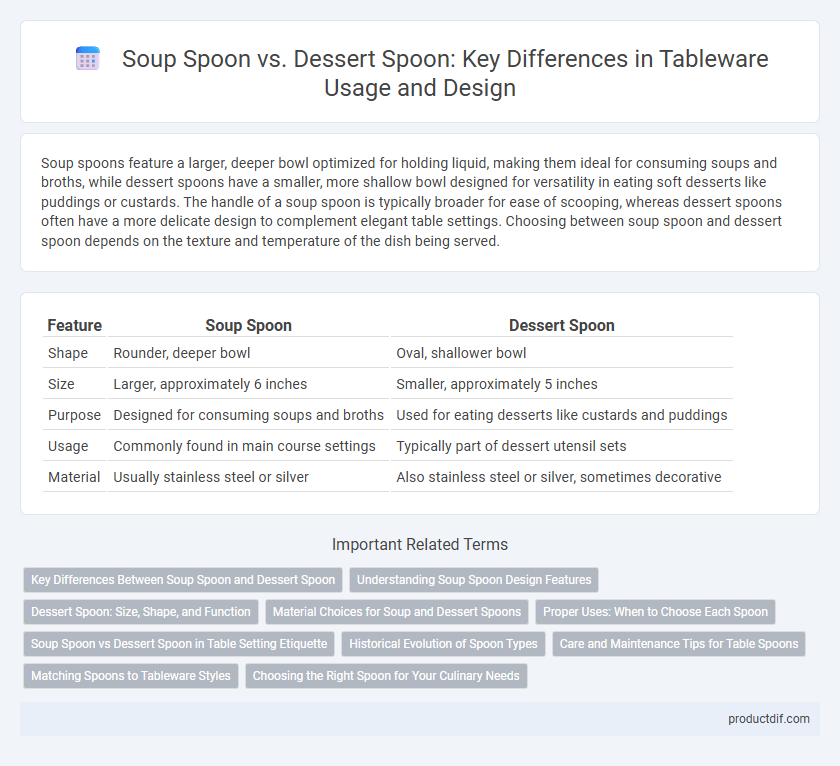Soup spoons feature a larger, deeper bowl optimized for holding liquid, making them ideal for consuming soups and broths, while dessert spoons have a smaller, more shallow bowl designed for versatility in eating soft desserts like puddings or custards. The handle of a soup spoon is typically broader for ease of scooping, whereas dessert spoons often have a more delicate design to complement elegant table settings. Choosing between soup spoon and dessert spoon depends on the texture and temperature of the dish being served.
Table of Comparison
| Feature | Soup Spoon | Dessert Spoon |
|---|---|---|
| Shape | Rounder, deeper bowl | Oval, shallower bowl |
| Size | Larger, approximately 6 inches | Smaller, approximately 5 inches |
| Purpose | Designed for consuming soups and broths | Used for eating desserts like custards and puddings |
| Usage | Commonly found in main course settings | Typically part of dessert utensil sets |
| Material | Usually stainless steel or silver | Also stainless steel or silver, sometimes decorative |
Key Differences Between Soup Spoon and Dessert Spoon
Soup spoons feature a round, deep bowl designed to hold liquid efficiently, making them ideal for broths and soups, while dessert spoons have a smaller, shallower bowl suited for eating solid or semi-solid desserts such as puddings and custards. The size of a soup spoon is generally larger compared to a dessert spoon, which is more compact to accommodate easier handling of sweet dishes. Soup spoons typically have a longer handle to facilitate sipping hot liquids directly from the spoon.
Understanding Soup Spoon Design Features
Soup spoons feature a rounded, deeper bowl designed to hold more liquid, facilitating the consumption of brothy soups and stews. These spoons typically measure around 6 to 7 inches in length, with a larger surface area compared to dessert spoons, which have a smaller, shallower bowl ideal for eating creamy or semi-solid desserts. The design focus on soup spoons enhances functionality by preventing spills and maximizing liquid intake in each bite.
Dessert Spoon: Size, Shape, and Function
Dessert spoons are generally smaller than soup spoons, measuring approximately 6 to 7 inches in length, with a more oval-shaped bowl designed for soft, sweet foods. Their compact size and slender profile make them ideal for eating desserts such as puddings, custards, or ice cream. Unlike the deeper, wider soup spoon bowl that holds liquids efficiently, the dessert spoon's shape facilitates scooping and tasting delicate textures without excess liquid retention.
Material Choices for Soup and Dessert Spoons
Soup spoons are commonly crafted from stainless steel to ensure durability and ease of cleaning, while ceramic and porcelain options offer elegance for formal dining settings. Dessert spoons often feature materials such as silver or gold plating to enhance aesthetic appeal and complement dessert presentation. Both types emphasize ergonomic design, but material selection balances functional use with visual refinement.
Proper Uses: When to Choose Each Spoon
Soup spoons, characterized by their larger, deeper bowls, are designed for consuming liquid-based dishes such as soups and broths, ensuring efficient sipping and minimal spillage. Dessert spoons, smaller with a more shallow bowl, are ideal for eating puddings, custards, and other semi-solid desserts where precision and portion control are important. Choosing the appropriate spoon enhances dining etiquette and user experience by matching the utensil's shape and size to the texture and consistency of the food.
Soup Spoon vs Dessert Spoon in Table Setting Etiquette
Soup spoons feature a rounder, deeper bowl designed for efficiently consuming liquids, while dessert spoons have a smaller, oval shape suited for eating solid or semi-solid sweets. In formal table setting etiquette, the soup spoon is placed to the outermost right of the dinner knife, indicating use during the soup course, whereas the dessert spoon often appears above the plate or is brought in with the dessert course. Proper placement of these spoons reflects both functionality and adherence to traditional dining protocols, enhancing the overall dining experience.
Historical Evolution of Spoon Types
The historical evolution of spoon types reveals that the soup spoon, characterized by its round bowl, originated in medieval Europe to effectively consume broths and soups. Dessert spoons, smaller with an oval shape, evolved later during the Renaissance to complement finer dining customs and delicate sweet courses. These distinctions highlight the adaptation of spoons to specific culinary functions driven by cultural dining practices over centuries.
Care and Maintenance Tips for Table Spoons
Proper care and maintenance of soup spoons and dessert spoons ensure their longevity and hygiene. Hand washing with mild detergent and drying immediately prevents tarnish and corrosion, especially for silver or stainless steel utensils. Regular polishing and storing spoons in a dry, lined drawer protect the tableware from scratches and maintain their pristine appearance.
Matching Spoons to Tableware Styles
Soup spoons feature a round, deep bowl ideal for brothy dishes and pair well with classic or formal tableware styles in silver or stainless steel finishes. Dessert spoons have a smaller, oval bowl designed for sweet courses and complement modern or minimalist table settings with sleek, polished designs. Matching soup and dessert spoons to tableware styles enhances both aesthetic appeal and dining functionality.
Choosing the Right Spoon for Your Culinary Needs
Selecting the appropriate spoon enhances the dining experience by matching utensil design to specific culinary needs. Soup spoons typically feature a larger, deeper bowl ideal for consuming liquids and broths, while dessert spoons are smaller with a shallower bowl suited for soft or semi-solid sweets. Understanding these distinctions helps in choosing the right spoon for serving and enjoying soups or desserts effectively.
Soup Spoon vs Dessert Spoon Infographic

 productdif.com
productdif.com